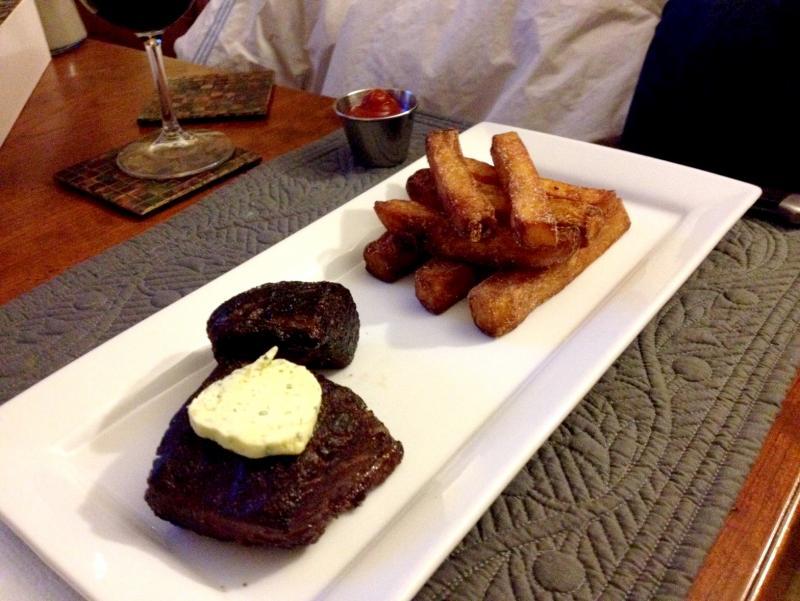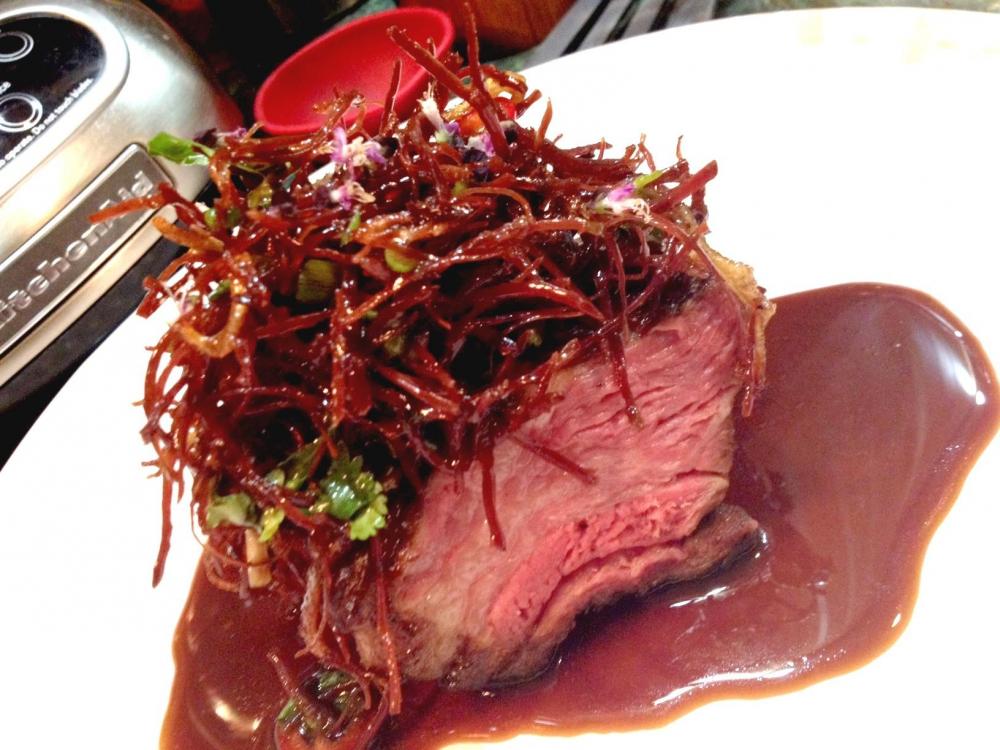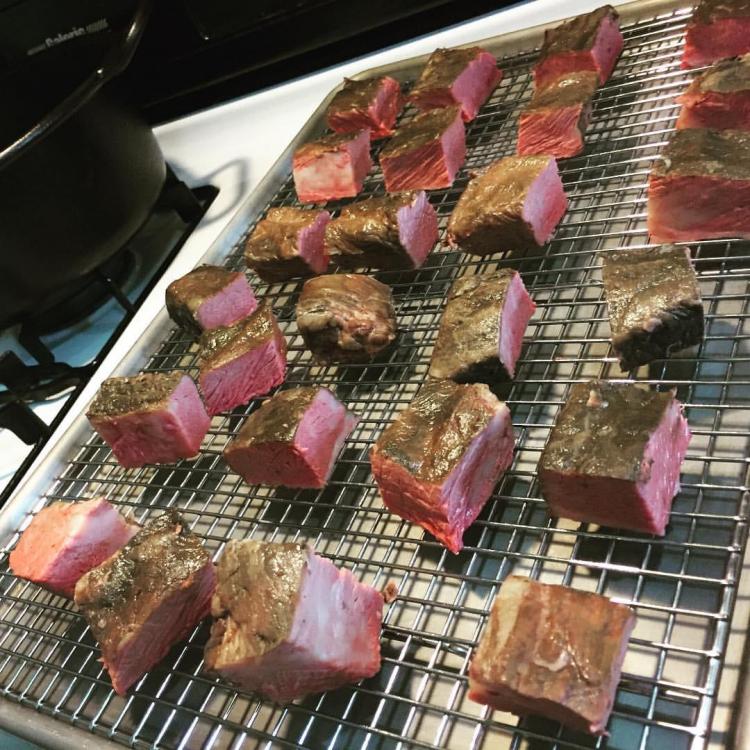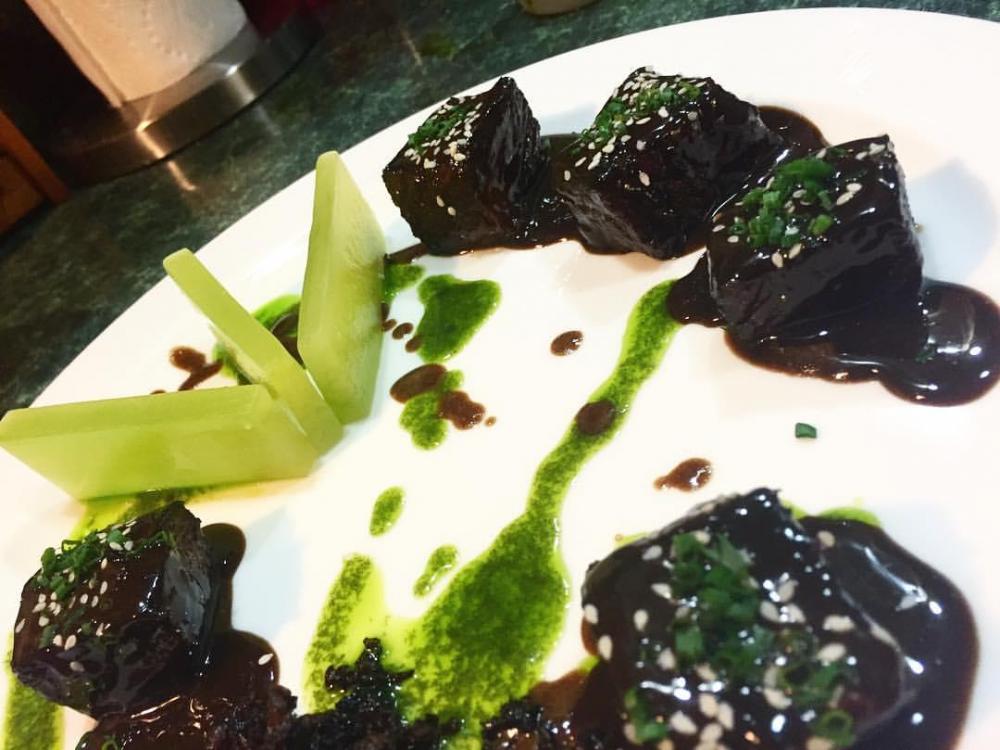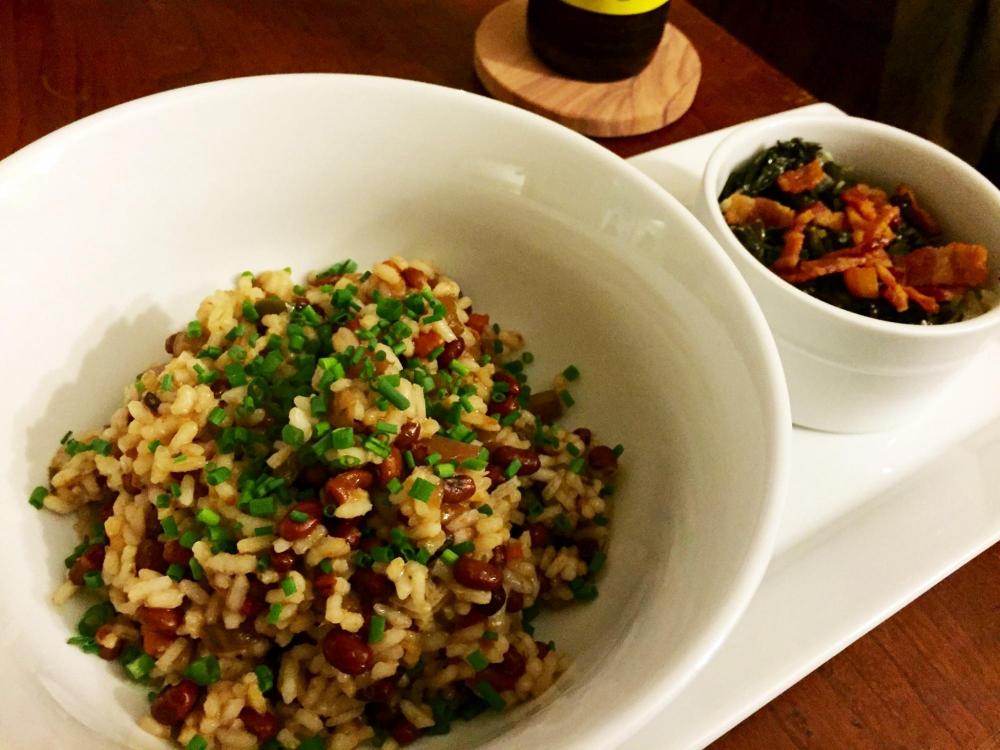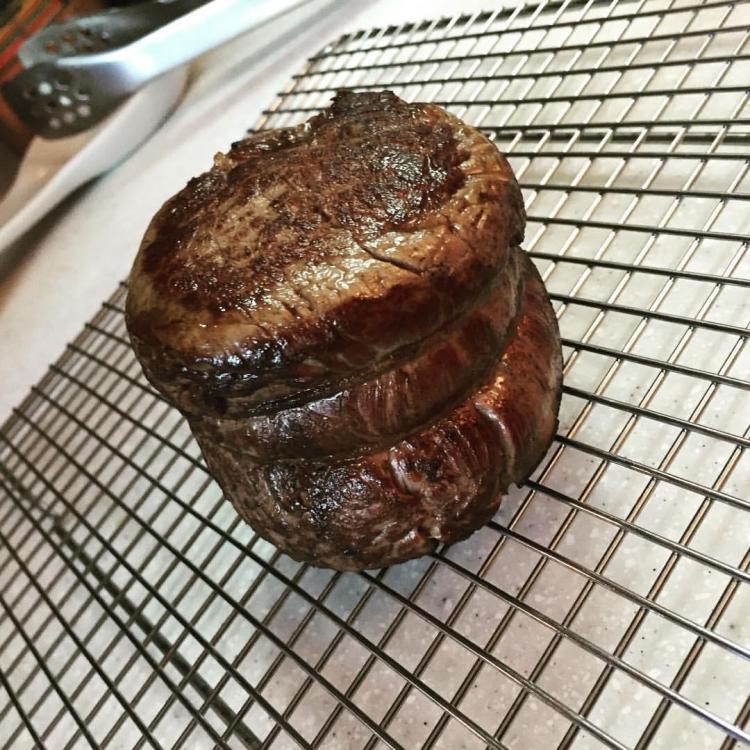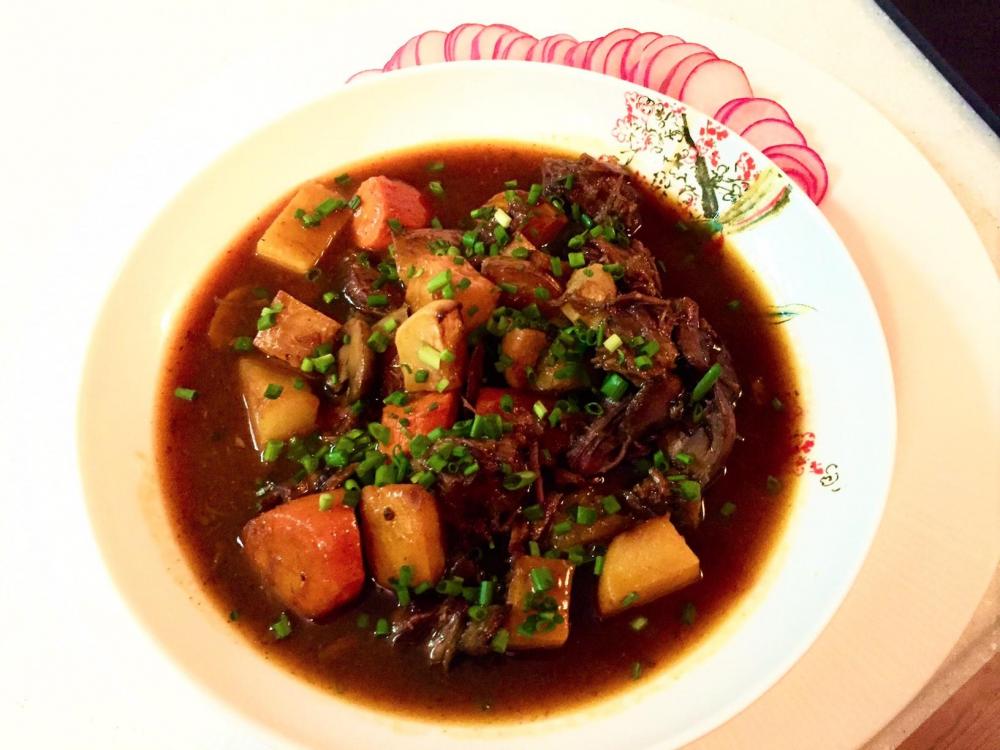-
Posts
1,807 -
Joined
-
Last visited
Content Type
Profiles
Forums
Store
Help Articles
Everything posted by btbyrd
-
Thanks! Wire racks are super-useful. They make them in both half-sheet and quarter-sheet pan sizes. I have several in each size. It's the best place to rest seared meat before plating because the crust won't get soggy. It's also good for resting fried foods because excess oil will drain off and your food won't be swimming in grease. The MC recipe is great; that glaze is especially fantastic. It takes a lot of work though... the demiglace is made from pressure cooked oxtail stock that's reduced 90% to a thick syrup and then infused with tamarind paste, fresh herbs, and some spices. The crispy beef threads and shallot "salad" are also tossed in the glaze. It's worth the effort. The worst part of the recipe is making the crispy beef threads. You basically cut flank steak into strips and marinate it in soy/fish sauce. Then you dehydrate the beef in the microwave. Because of the fish sauce, this step makes your house smell like rotting fish for a day or so. After it's dehydrated, you have to pull the fibers of the muscle into individual strands. This takes for-ev-er. Seriously. Forever. The final steps of the dish come together very nicely though. You deep fry your short ribs, deep fry thinly sliced shallots, and deep fry the dehydrated beef threads. Toss the shallots and beef threads together with some herbs and the demi glace, and plate, plate, plate. It is freaking delicious. Tastes so good, makes you wanna slap your mama.
-
Seems like people in this thread have had bad luck with short ribs. I've never, and I mean NEVER, had bad luck with short ribs. I either go 48hrs @ 60C or 72hrs @ 54C. Either way, the results are great. Frites with Triple Cooked Chips. (This was my wife's portion, which explains the ketchup instead of mayonnaise). MC 72HR short rib with Sweet/Sour/Savory Glaze and the beef-thread/fried shallot "salad": 72hr short ribs, deboned, trimmed, and portioned into cubes... waiting for the deep fryer: Deep fried short ribs with Asian-infused shortrib demiglace, cilantro/chive macadamia nut oil, lime-infused cucumber planks: I'm making me hungry.
-

Wire shelving - no casters or casters, opinions wanted
btbyrd replied to a topic in Kitchen Consumer
I have two racks in my home kitchen: one for appliance storage and one for dry goods storage. Neither have casters because I never need to move them (except for cleaning purposes). If these will be in a fixed location, casters aren't really necessary... although wheels do facilitate pulling them out from the walls and cleaning behind/underneath them.- 20 replies
-
- 1
-

-
- Chocolate
- Confections
-
(and 1 more)
Tagged with:
-
My responses mirror @DiggingDogFarm's: I love them, but mostly try to avoid eating starches, so bean-eating is a special occasion. For that reason, on the rare occasions that I cook pulses, they tend to be the main event rather than a side dish. As for dish recommendations, it's hard to beat Martin's suggestion of cassoulet... but since I'm a Southerner, I'll plug for Hoppin' John. Sean Brock's recipe is great (and includes a tasty, blended-bean gravy sauce). Field peas and Carolina Gold rice from Anson Mills are a must. And, as if it needs to be said, I'm a huge fan of Rancho Gordo products. They sell some beautiful, beautiful varieties.
-
Modernist Cuisine reports that steaming is actually slower than boiling for many foods (Vol 2, p. 70-73). They constructed an experiment where a thermocouple was placed at the center of two identical aluminum cylinders, which were then "cooked" in either boiling water or steam. Boiling was consistently faster than steaming. The blog Genuine Ideas performed a similar test using carrots and found that boiled and steamed carrots cooked at the exact same rate. Whatever the case, steaming isn't faster. Steaming can be "faster" than boiling in contexts where you're cooking a lot of product. From start to finish, it's probably faster to steam 10lbs of potatoes than to boil them, given how much water boiling would require (and that you may have to cook them in batches). In any case, I pressure cook large amounts of potatoes.
-

Single burner induction cooktop with easy temperature adjustment?
btbyrd replied to a topic in Kitchen Consumer
I will say that one of my favorite capabilities of the Mirage Pro is in making slow-cooked scrambled eggs. Heston Blumenthal has a great method for making rich, custardy scrambled eggs using a double boiler. They take forever, but they're delicious. Because it's sort of fussy to break out a double boiler for breakfast, I've approximated them in the past, not using a double boiler, by taking a pan on and off the heat to manually regulate the temperature, ensuring that the eggs don't overcook and that I avoid the formation of large "curds." With the Mirage, I'm able to set the temperature of the pan in 5 degree (C) increments, so I'm able to make this style of egg without either using a double boiler or babysitting the pan to maintain temperature control. I simply set the temperature for 65C - an ideal egg-cooking temperature - and let the pan warm up with butter while I crack the eggs and get to work on the rest of breakfast. When the pan is up to temp, I can just add the eggs and not have to worry about them overcooking if I forget to stir for a few minutes. In the event that I have to walk away, I turn the temp down to 60 or 55, and they stay hot without continuing to appreciably thicken and cook. If I'm getting closer to breakfast and want to rush things along, I can turn up the temperature to 70C and finish up relatively quickly. To overstate things, this has revolutionized the way I make scrambled eggs on lazy weekend mornings. I will say that this technique, and (apparently) the temperature control generally, doesn't work well at all if you're using light weight pans. I cook mostly with relatively heavy carbon steel, cast iron, or All Clad stainless pans, and none of them have given me issues with the Mirage. However, the one time I tried to make this recipe with a much thinner non-stick pan from T-Fal that was a top choice from Cook's Illustrated and ATK. Since induction heats the pan and not the burner, and since thermostatic temperature control on induction units registers the heat of the ceramic material on top of the "burner" rather than the actual temperature of the pan, that particular nonstick pan overheated before the relatively low temperature of 65C was registered by the cooktop. When I added butter to the pan, it rapidly foamed and started to burn because the pan was much hotter than the thermostat realized. I have since decided that non-stick pans are basically worthless compared to the alternatives, so this isn't an issue for me anymore. I think this would have been an issue on every other induction burner, so that's something to think about when using thinner, less massive, non-stick pans with induction -- even if they're "induction ready." In you want to use a pan like that, just go by power settings rather than trying to use temperature control. But with pans of moderate weight, the temp control is very nice on the Mirage. It's nowhere as extreme as the Breville Control Freak, but it's insanely better than the cheaper units. -

Single burner induction cooktop with easy temperature adjustment?
btbyrd replied to a topic in Kitchen Consumer
Looking through a few more reviews, it appears that someone had theirs malfunction during what would have been a warrantied period (13 months after purchase, with a 2-year warranty). Vollrath didn't cover it. The consumer was understandably angry about the whole thing. I don't understand Vollrath's policy here. It seems to be the exact opposite of what it should be. Vitamix, for example, offers a SHORTER warranty on commercial units, precisely because they'll be used and abused far more than they will in your average home cook's kitchen. The idea that you would sell a piece of equipment that functions perfectly well in a home kitchen, but only give a warranty for professional use is bonkers. Given that I don't have unlimited financial resources, if I were buying again, I would stick to my original strategy of watching eBay for heavily discounted used or open-box units and just accept that it doesn't have a consumer warranty. They are much, much better than the inexpensive burners in every possible way (noise, temperature control, build quality, ease of use). The risk is tolerable, given my preferences. -

Single burner induction cooktop with easy temperature adjustment?
btbyrd replied to a topic in Kitchen Consumer
I'm still loving it, but I can't really comment on the warranty issue since I got mine used. Try calling or e-mailing Vollrath directly to see what they say. Their website emphatically (bold allcaps) says that they do not offer a written warranty on items purchased for personal or household use. What that means in practice, I cannot say. I do know that there are a lot of people (like myself) who use the Mirage in a non-commercial setting and have no worries about doing so. It's a very well made unit, and I wouldn't expect it to malfunction or break (pretty much ever). However, given that it's an expensive unit I can understand wanting to be sure that you'd be covered in the event that something goes wrong. Someone asked a question about this on Amazon, and GlennR replied: That sounds about right to me. Call or e-mail Vollrath and see what the deal is. And report back with your findings! -
You can also carbonate kimchi, if you're so inclined.
-
I haven't used a steamer to cook vegetables in years. Microwave all the way. Glass or ceramic bowl + veg + plastic wrap. There you go.
-
Even if you're doing the water displacement method for sous vide, it can still (almost) make sense to buy chamber vacuum bags. They're cheaper than Ziplocs and you can just clip them to the side of your SV container. I do this quite frequently even though I have a chamber vac. If I'm cooking a few items (like a couple of steaks, a chicken breast, or a single rack of ribs) I just put the food in, pop them in the water, and either clip them in or place the lid on top so the bags are secured. You see the ChefSteps crew doing this a lot in their videos. I mostly seal for large batches, long cook times, items that have a lot of liquid in the bag (which also tend to be long-cooking), and anything that will be chilled and stored (or frozen). I'm somewhat overstating the case here... it doesn't make total sense for someone without a chamber vac to buy chamber bags. But it also sort of does make sense. Almost.
-
Oil pumps in vacuum machines don't smell and they're not messy. Also, they make chamber vacuum sealers with dry piston pumps. They're still expensive and heavy, but there's no need to change the oil (though the pumps apparently don't last as long). Regardless, for any chamber machine the cost of the bags is considerably cheaper than it is for edge sealers. Over the course of the life of using the machines, the cost of the bags for edge sealers makes them much more expensive than they seem when making the initial purchase.
-
If your technique is flawless, you can put a monster sear on a steak with no sticking... like on this righteous pre-SV sear on my wife's tenderloin. Solid crust... totally raw inside. You may smoke out your house for a day or so, though... so ensure you have proper ventilation. I recently moved and this steak lead me to the discovery that... no, I don't have proper ventilation. The delicious smell of beef smoke has mostly subsided in the week that passed. Mostly.
-
There's no reason it shouldn't work in a heavy clad pan. I've done it with my All Clads before, but the reason I prefer cast iron or carbon steel is for simple thermal mass, which is a great asset when searing. (Seasoned cast iron/carbon steel also have some non-stick properties that help with release when searing, but if you don't try to move steak around before it's properly seared, that shouldn't be an issue.) If your burner can get hot enough for the pan to recover quickly, there's no reason not to go with the stainless/aluminum sandwich. Ha!
-
My wife likes tenderloin (bless her heart) and she likes it medium-to-medium-well (bless her heart). It can be a challenge cooking a thick filet through to her desired doneness in the center without turning the exterior to leather. But I can get easy, repeatable results using either sous vide or a very low oven. For both techniques, I sear the meat off hard in ripping hot cast iron or carbon steel pan... oil the meat, not the pan, to prevent fires and excess smoke. Then I'll either chill and bag it (for SV) or move it to a cooling rack set over a sheet tray lined with foil (for easy cleanup). In the latter case, I'll then move it to a 225F oven with a probe in the center for as long as it takes to come up to temp. The gentle heat generates a very little temperature/doneness gradient inside the filet. I've also gotten great results using the Heston method of using medium-high heat in a pan and flipping the steak every 15-20 seconds, but that takes forever with a thick cut and requires a ton of babysitting. The SV and oven methods are easy, hands off techniques (and both allow for sme wiggle room toward the end of cooking while you prepare other items).
-
I'd like to see more pics of it from the side as well as seeing it used on multiple containers (like a big Cambro or cooler or something with a wider lip). And also on taller containers.
-
The term "superfood" is a marketing ploy, but that doesn't mean that foods with that label aren't beneficial to health when incorporated into a healthy diet. A big problem with how the public views these foods is that many seem to think that adding an extra avocado or goji berry to the Standard American Diet will make them immortal. And that's silly. You cannot judge the healthfulness or "superfoodiness" of a food item in isolation, but must consider the entirety of a person's diet as well as that person's overall health (e.g. age, weight, insulin sensitivity, etc...). However, if one were to adopt a diet based on whole foods (for lack of a better term) that includes many "superfoods" as keystones.... lots of leafy greens, berries, brassicas, avocados, garlic, pastured eggs, and small, oily fish along, etc, and lots of "superfood" fats like coconut oil, EVOO, and grassfed butter instead of canola, soybean, and corn oil... perhaps replacing sugary sodas and juices with coffee, green tea, and mineral water... that can make a huge difference. But that's a systemic change, not an incremental one. Eating one extra serving of superfood a day won't do much (anything?) for you if the rest of your diet is garbage.
-
Great idea! I can see myself doing the same thing after Joule gets here. My Polyscience Pro is too big and the pump is too strong for that to work well in the time being. That makes sense. As a fun technical exercise I'm going to try to devise a few "one pot" IP meals to cook in the near future. We just moved into a new house and the kitchen is huge and the appliances are great, but it lacks a dishwasher (and proper ventilation). I've made my peace with washing dishes/pots, but the fewer, the better.
-
Broke in my IP the other day with a chuck roast from the farmer's market. Cubed, oiled, oven seared... then PC'd for 35 minutes in the IP in short rib stock with mirepoix, anchovy paste, tomato paste, Marmite, fish sauce, and MSG. Vented, removed veg, strained stock, reduced by half. Added a small amount of corn starch. Returned beef to broth and added sauteed mushrooms (seared in IP) and oven roasted turnip, rutabaga, carrot, and potato. Set to "keep warm" for 30 minutes to let things mingle. So far I like the IP a lot. I really appreciate how sturdy the stainless steel inner pot thing is. For reducing the stock, I pulled it out of the IP and stuck it on my induction burner, then returned it to the IP when that was done. I like the size of it... I may even use it to cook with when I'm not using the IP's gadgetry.
- 483 replies
-
- 11
-

-
I can't even begin to imagine cooking broccoli in a pressure cooker unless my intention was to puree it (which I've done before for soup, with great results). If you want to eat it straight up, cook it in the microwave in a covered bowl for like 2 minutes. Or just steam it (more cleanup, but hey). Pressure cooking is best used for shaving hours (or half hours) off of long-cooking items like dried beans, tough meat, or stock. It's also great for cooking the bajeebers out of things you want to blend into an ultra-smooth soup or puree. But for quick cooking items? I just don't get it.
-
That said, I'm glad some of you are having fun with yours. But I'll stick to my dutch oven filled with lard or tallow if I want to fry something. It's cheaper... and it actually fries things!
-
Air fryers are lies. Needless kit like nonstick pans. Fat is not evil.
-
The article omits the secret ingredient that Lisa's recipe includes: MSG. The current version of the "original recipe" has been so tweaked out by industrial food chemists as to be basically unrecognizable. I wonder what the original really tasted like.
-
Just moved and broke in my circulator in the new kitchen. Sort of. Tonight was SV halibut -- 45 minutes @ 131F with olive oil and lemon rinds. Then a hard sear in cast iron before saucing with a dandelion/basil pesto (with mushy peas and a caprese salad). Tastiness all around. But I don't consider a 45 minute SV cook a true "breaking in" of the new kitchen.
-
I didn't have one yet... I have a stovetop pressure cooker and a rice cooker (which is going up on eBay momentarily), but no slow cooker (but several dutch ovens and an actual oven... and a circulator). So. I didn't really *need* the IP, but it will be a good addition to the batterie de cuisine. And my current rice maker (a Zojirushi NS-PC18) is designed to make a gigantic quantity of rice -- much too much for my 2-person household. So a downgrade there is actually welcome. And my 8 quart pressure cooker feels like overkill for smaller jobs, so again it will be nice to have a smaller option. I didn't force you to do anything! I just made you aware of an offer you couldn't refuse. I couldn't refuse either.


